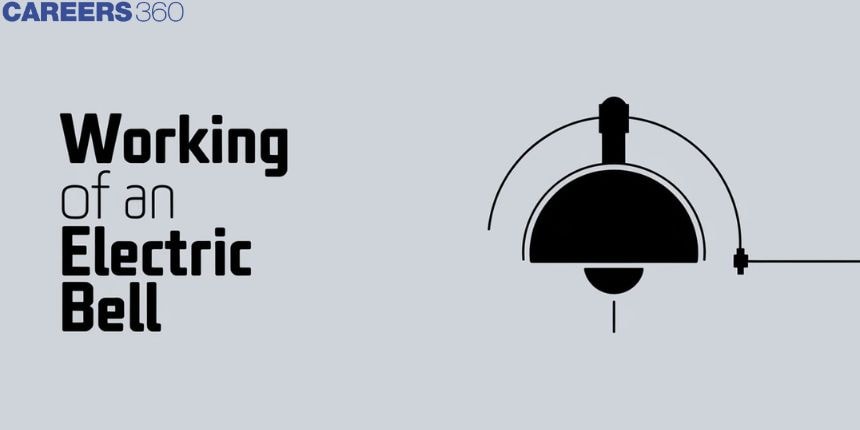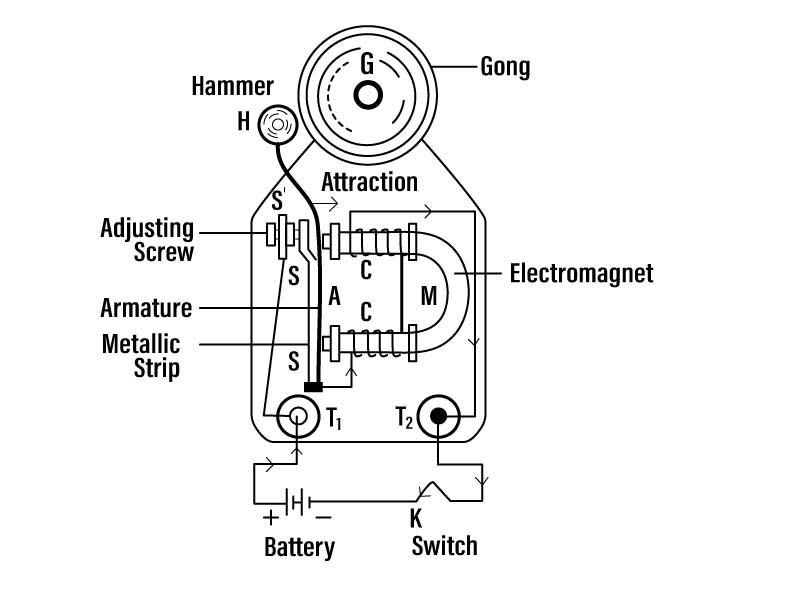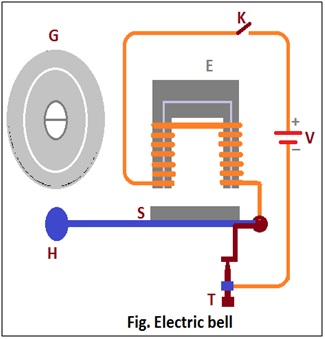Working of an Electric Bell - A Complete Guide
Have you ever walked to someone’s door, pressed a small switch, and heard a bell ring inside the house even when no one was near the door? This everyday moment shows the power of electromagnetism, which turns electrical energy into sound. The electric bell is one of the simplest and most common applications of this concept. From doorbells to school bells and alarm systems, this device plays a big role in our lives. In this article, you will learn What is an electric bell?, Electric bell diagram, Construction of an electric bell, Principle of working, What is an electromagnet?, How electromagnetism makes the bell ring and Working of electric bell.
This Story also Contains
- What is an Electric Bell?
- Electric (door) Bell diagram
- How to Draw Electric Bell (easy diagram)
- Principal on Which Electric Bell Works
- What is an Electromagnet?
- Working of Electric bell

Also read -
What is an Electric Bell?
Bell – bells are instruments that generate vibrations or sound when triggered. There are many types of bells like a temple bells, school bells alarm clock bells and doorbells etc.
In class 7 we are understanding how an electric bell works mainly.
Definition of Electric Bell- An electric doorbell is a bell that is used usually in our homes, and after pressing the switch, the circuit working on the principle of electromagnet is completed hence leading to the triggering of the sound.
Electric (door) Bell diagram
Electric bell is a circuit of various parts like a gong, electromagnet, hammer, adjusting screw, armature, metallic strip, switch and a battery for bell.
As we can see in this diagram of electric bell one end of the electromagnet is connected to the terminal t1 that is switch of the circuit and another is connected to second terminal t2 that is battery of bell. When the hammer at the top touches the adjusting screw, the steel rod functions as a spring hence, the hammer contacts the other terminal of the battery and that’s hoe this circuit performs its individual function.
Now, let’s see how to draw a labelled diagram of working of electric bell.

How to Draw Electric Bell (easy diagram)
This is the image of the easy bell diagram.

Principal on Which Electric Bell Works
Electric bell works mainly on the principle of an electromagnet which is the magnetic effects of current.
So, before knowing the principle we all should be aware of the term electromagnet because the electric bell has electromagnet as its main component.
What is an Electromagnet?
An electromagnet is a temporary magnet created when electric current passes through a coil of wire wound around a soft iron core.
Why soft iron is used?
- It magnetizes strongly when current flows
- It loses magnetism quickly when current stops
- Makes the bell operate smoothly and repeatedly
Electromagnets are used in electric bells because they can be switched ON and OFF instantly.
Working of Electric bell
Step 1: Switch is pressed
A current flows from the battery through the coil of the electromagnet.
Step 2: Electromagnet becomes active
The coil now acts like a magnet and attracts the iron armature.
Step 3: Hammer strikes the gong
As the armature moves, the hammer hits the bell and produces sound.
Step 4: Circuit breaks automatically
When the armature moves towards the electromagnet, it breaks the circuit at the contact point.
Step 5: Electromagnet turns OFF
Armature returns to its original position due to the spring.
Step 6: Circuit completes again
Current flows once again → electromagnet becomes active.
This process repeats rapidly, making the bell ring continuously as long as the switch is pressed.

Also check-
- NCERT Exemplar Class 11th Physics Solutions
- NCERT Exemplar Class 12th Physics Solutions
- NCERT Exemplar Solutions for All Subjects
Frequently Asked Questions (FAQs)
The electric bell was invented by Joseph Henry, an American scientist, in the 1830s
- Scientific equipment used in preserving cultures.
- Replacement of classical bells.
- Variety of uses with numerous needy and important features.
- Live broadcasting via microphones are done.
- Less weight without any risk of structural failure.
The important characterstics of an electromagnet are:
(I) an electromagnet is temporary in nature that is, it can be demagnetized when magnet is not in use.
(ii) an electromagnet is made of a soft iron core rod because of it’s nature.
(iii) the magnetic field strength can be changed by various methods like by increasing number of turns on solenoid or by increasing the current in the circuit.
(iv) an electromagnet can be easily demagnetized in a very less interval of time by switching off the current.
No, bulb does not have electromagnet in it. It’s rays are electromagnetic radiations because of light’s nature.
The electromagnet attracts the hammer. Electric bell contains making and breaking of the switch, which the iron armature keeps the bell ringing. It breaks the circuit, so a current no longer flows and hence, making the electric bell ring again and again.
In electric bulb, the filament of the bulb produces light because of the heating effect of electricity. The filament of bulb is usually made of tungsten metal; whose melting point equal to 3380°c so that it does not melt easily.
The working of an electric bell for Class 7 students is based on the concept of electromagnetism.
An electric bell is a mechanical device that uses electrical energy to produce sound. It works on the principle of electromagnetism. When electricity flows through an electromagnet, it creates a magnetic field, which moves a striker or hammer to hit a bell and produce a ringing sound.